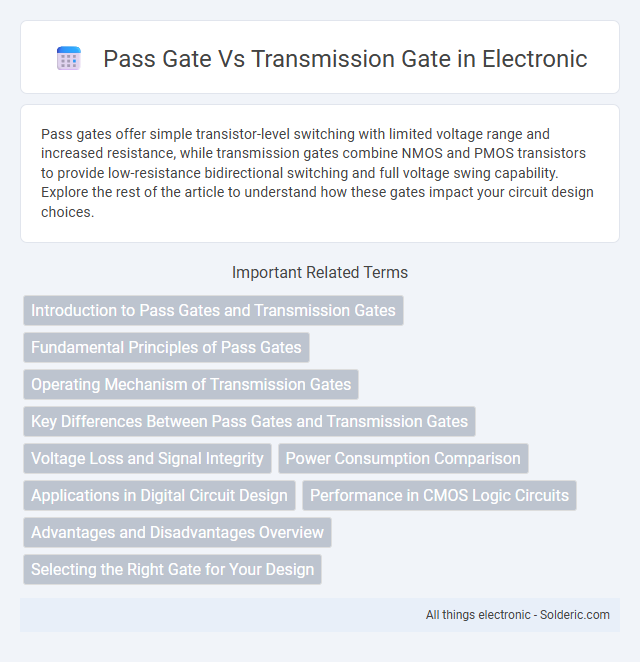Pass gates offer simple transistor-level switching with limited voltage range and increased resistance, while transmission gates combine NMOS and PMOS transistors to provide low-resistance bidirectional switching and full voltage swing capability. Explore the rest of the article to understand how these gates impact your circuit design choices.
Comparison Table
| Feature | Pass Gate | Transmission Gate |
|---|---|---|
| Structure | Single transistor (typically NMOS) | Parallel combination of NMOS and PMOS transistors |
| Signal Transmission | Effective for low logic levels; weak at high levels | Efficient transmission for both high and low logic levels |
| Voltage Drop | Voltage drop occurs for logic '1' due to threshold voltage | Minimal voltage drop as complementary transistors compensate |
| Control Signals | Single control signal (gate voltage) | Complementary control signals (gate and inverted gate) |
| Applications | Simple switches in low voltage regions | Multiplexers, analog switches, efficient CMOS logic |
| Power Consumption | Lower due to fewer transistors | Higher, for improved signal integrity |
| Complexity | Simple | Moderate |
Introduction to Pass Gates and Transmission Gates
Pass gates utilize a single type of transistor, either nMOS or pMOS, to control signal flow, making them simple but limited by voltage drop issues. Transmission gates combine both nMOS and pMOS transistors in parallel, offering superior signal integrity by minimizing voltage loss and enabling bidirectional switching. Your choice between pass gates and transmission gates affects circuit performance, especially in analog multiplexers and digital logic design.
Fundamental Principles of Pass Gates
Pass gates operate by using MOSFETs as electronic switches that control signal flow based on gate voltage, allowing or blocking current without voltage amplification. Transmission gates combine both N-channel and P-channel MOSFETs in parallel to provide bidirectional conduction with lower resistance and reduced signal distortion compared to single NMOS or PMOS pass gates. Your circuit design benefits from understanding that transmission gates deliver superior efficiency and signal integrity in switching applications due to their complementary transistor configuration.
Operating Mechanism of Transmission Gates
Transmission gates operate by using complementary MOSFET pairs--both NMOS and PMOS transistors--to pass voltage signals efficiently with minimal threshold voltage loss. When enabled, the NMOS transistor conducts strong signals near ground, while the PMOS transistor passes signals close to the supply voltage, ensuring full voltage swing and low resistance. This complementary action allows transmission gates to achieve bidirectional signal transmission with enhanced linearity and improved on-resistance performance compared to single pass gates.
Key Differences Between Pass Gates and Transmission Gates
Pass gates use a single transistor, typically an NMOS or PMOS, allowing signal transmission with voltage drop issues, while transmission gates combine both NMOS and PMOS transistors to provide bidirectional voltage transfer with minimal signal degradation. The key difference lies in transmission gates offering full rail-to-rail voltage passage, ensuring better performance in digital circuits, whereas pass gates are simpler but suffer from threshold voltage loss. Your circuit design benefits from choosing transmission gates when signal integrity across varying voltage levels is critical.
Voltage Loss and Signal Integrity
Pass gates typically introduce voltage loss due to threshold voltage drops across MOS transistors, which can degrade signal integrity in low-voltage applications. Transmission gates, combining parallel NMOS and PMOS transistors, minimize voltage loss by allowing signals to pass with reduced threshold voltage drop, preserving signal amplitude more effectively. This enhanced signal integrity makes transmission gates preferable for analog switches and multiplexers requiring minimal distortion and accurate voltage levels.
Power Consumption Comparison
Pass gates typically consume less power than transmission gates because they use fewer transistors, reducing leakage and switching currents. Transmission gates, combining both NMOS and PMOS transistors, offer better signal integrity but with slightly higher dynamic power due to increased capacitance and transistor count. Your choice depends on balancing power efficiency against output signal quality in low-power circuit designs.
Applications in Digital Circuit Design
Pass gates are commonly used in multiplexers and simple switching applications where minimal area and power consumption are essential, providing efficient signal transmission with fewer transistors. Transmission gates, leveraging both NMOS and PMOS transistors, excel in analog switches, data selectors, and sampled data circuits by offering low on-resistance and reduced signal distortion across the entire voltage range. Your digital circuit designs benefit from transmission gates when high fidelity and bidirectional switching are critical, while pass gates serve well for straightforward logic-level signal routing.
Performance in CMOS Logic Circuits
Pass gates, typically implemented using a single type of MOS transistor, offer faster switching speeds but suffer from threshold voltage drops, which can degrade signal integrity in CMOS logic circuits. Transmission gates combine both NMOS and PMOS transistors, minimizing voltage drop and providing full rail-to-rail signal swing, which improves signal fidelity and reduces delay in complex CMOS logic designs. Transmission gates generally exhibit better overall performance in terms of noise margin and power efficiency for critical path signals within CMOS integrated circuits.
Advantages and Disadvantages Overview
Pass gates offer low transistor count and reduced area, making them ideal for simple switch applications with minimal power consumption. However, they suffer from threshold voltage drop issues, leading to signal degradation and slower switching speeds in low-voltage circuits. Transmission gates overcome these limitations by using complementary MOSFETs to provide full voltage swing and reduced signal loss, but they require more transistors and increase circuit complexity and area.
Selecting the Right Gate for Your Design
Pass gates, typically implemented with a single NMOS transistor, offer lower conduction resistance but do not transmit strong logic high levels, making them suitable for designs requiring efficient low-level signal passage. Transmission gates combine NMOS and PMOS transistors to provide full voltage swing and minimal signal distortion, ideal for applications needing bidirectional switching and integrity across voltage levels. Your design choice depends on signal amplitude, power constraints, and required logic levels, with transmission gates favored for balanced performance and pass gates chosen for simpler, low-power scenarios.
Pass Gate vs Transmission Gate Infographic

 solderic.com
solderic.com